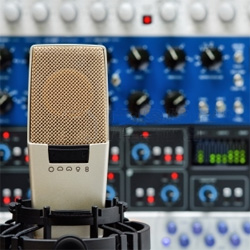Since I’m both a singer and an audio guy, I’ve spent a lot of time mixing my own voice. Whether it’s voiceover stuff for my two different podcasts and videos or simply me singing lead vocals on a tune, I’ve logged hundreds of hours listening to and mixing my own voice.
At this point, when I’m mixing one of my own songs, I can usually EQ the lead vocal in less than 60 seconds.
Over the years I’ve tried everything under the sun on vocals, and I’ve landed on a few settings that work particularly well on my voice. I want to share some of those with you today.
Keep in mind, these settings work well on MY voice. They won’t work on every voice you mix, but if you’re working on a project with a male lead singer, this will give you a good starting point.
1. High-Pass Filter
This is a given on almost every vocal track I’ve ever mixed. Sometimes you capture some extra low-end rumble in the vocal mic, which can quickly muddy up your mix.
Set a high-pass filter at around 100 Hz to start. You can go lower or much higher. Let your ears guide you.
2. Low-Mid Cut
I find myself almost always doing some sort of wide cut in the low-mids on my voice. The specific frequency varies from song to song, but it’s usually somewhere between 150 Hz and 500 Hz.
This cut brings clarity back to the vocal, and gets rid of some of the “resonance” or “ringing” sound that tends to happen on a male vocal recording.
I’m usually not cutting more than 3-5 dB here, and I normally use a fairly low Q (making it a nice, wide cut).
3. High-Mid Cut
This is something I didn’t do for years, and when I finally discovered it, it took my vocals to a new level.
My voice, when recorded, tends to sound a bit nasally. That “nasal” sound lives around 3 kHz or so. By adding another wide cut here, I can tame the nasal sound, giving my voice much more warmth without sacrificing clarity.
The upper mids can be really difficult to navigate (on any track, not just vocals), so be patient. A soft cut at around 2-4 kHz can work wonders on a nasally, harsh vocal.
4. High-Shelf Boost
I won’t use this every time, but if the vocal needs a little bit more “air” on the top, I’ll use a high shelf to slightly boost everything above 8-11 kHz or so.
I find myself doing this more when the vocal was recorded using a dynamic mic, since dynamics typically don’t have a lot of high end.
The key here is moderation. It’s easy to overdo this, leaving you with a harsh, piercing vocal sound. Aim for 2-3 dB max to start.
OK, now that I’ve given you a starting point, spend a lot of time simply practicing mixing male vocals.
Joe Gilder is a Nashville-based engineer, musician, and producer who also provides training and advice at the Home Studio Corner. Note that Joe also offers highly effective training courses, including Understanding Compression and Understanding EQ.





















